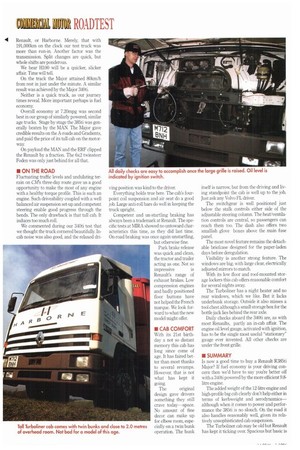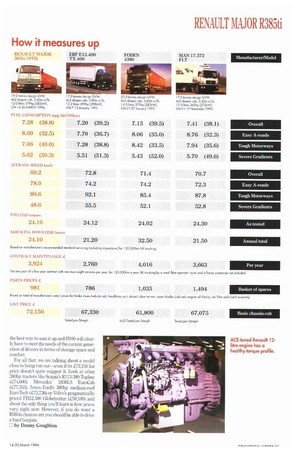M OE H AP P Y
Page 28

Page 30

Page 32

Page 33

If you've noticed an error in this article please click here to report it so we can fix it.
With a new heavy truck range poised in the wings we thought we'd take a final look at Renault's long-serving Major R385ti Turboliner tractor powered by its own 12litre straight-six to see if it will be missed. Should remaining models be snapped up?
C Id soldiers never die...they just fade 0
:lway". That trite little one-liner on
the fate of unwanted warriors could easily describe the future for Renault's Major tractor. Sporting a cab that first saw light of day in the seventies as a Berliet, the R-range, or Major as it has been known latterly, has been a steady enough campaigner for Renault over the past 10 years. But in the battle for new truck sales it's been suffering under the attack from young whipper-snappers from Volvo and Scania to the point that it's just about ready for its demob.
Fortunately for Renault the cavalry's coming in the shape of its long-awaited new truck range, codenamed H100, which will enter the fray soon. But it will be some while before we see those new models in any great numbers, so we thought we'd take one last look at the Major to see if it will be missed, not least as it's still a current model and prices are bound to get keener as H100 draws nearer.
It would be fair to say that over the past few years Renault VI (UK) has been rather reluctant to provide us with test trucks. The situation is due to change as we've been promised an H100 just as soon as it's officially launched. Let's hope so.
Meanwhile we've found our trucks outside Dunstable in order to put the French manufacturer's products to the test.
Ultely we've been helped by op, 41 Wellingborough-based Renault main dealer Harborne. Like the Manager G340ti we recently tested back in October last year, this week's offering, a Major 385ti Turboliner, has come from Harborne's rental fleet.
It's not the first Major we've tested. Less than a year ago we took a Major 340ti, powered by Renault's trusty 9.8-litre straight six. around our Scottish test route where it returned more than 8mpg—not bad for an old stager! So we were keen to see if the same truck with the more powerful 12-litre six-pot could still deliver the goods, • PRODUCT PROFILE Say what you like about the R-cab, it's lasted the test of time thanks to constant tweaking and facelifting The last major external changes occurred in 1990 with interior revisions following in 1991. A special air kit designed to smooth the air over the front and sides of the cab was also introduced some two years ago on right-hand drive models.
The optional high-roof twin-bunk Turboliner cab sits on a four-point coil-spring, damper and anti-roll bar suspension and provides close to two metres of interior height. That should be enough to face up to most other big cab challengers. If you need maximum living room then the Magnum will do a better job.
Underneath sits Renault's own MIDR 06.37.40 N/3 12-litre lump. In its current ACE configuration the charge-cooled straightsix puts out 385hp (283kW) and a useful 1,3581bft (1,840Nm) of torque at 1,200rpm.
The ACE nomenclature—Advanced Combustion engineering— was introduced on 12litre engines early in 1992. The changes included work on the 12litre's combustion chambers and internal aerodynamics although it retained a mechanically controlled fuel injection system and it's stayed that way up to and including Euro-1.
Power is transmitted to the road via the standard B18 18-speed range change and splitter syncho box (the TBV semi-auto box is offered only as an option on left-hookers) and Renault's P1384C hypoid back axle. Our 3.6m wheelbase test tractor had steel springs on the front axle and the standard Airtronic two-bag air suspension on the rear. The driver can adjust the ride height of the tractor from within the cab or with a remote wander lead making coupling up a breeze.
Renault has long been at the forefront of disc-brake technology on heavy trucks and the R385ti is no exception with ventilated discs on its steer axle. Among the goodies on our tractor were electric windows and mirrors and a Webasto night heater—otherwise it's your bog-standard Major.
• PRODUCTIVITY Straight line acceleration in this, the most powerful right-hand drive Berliet-cabbed Renault, was not as quick as expected. We put this down to old age. That's no criticism of • Renault, or Harborne. Merely, that with 191,000km on the clock our test truck was more than run-in. Another factor was the transmission. Split changes are quick, but whole shifts are ponderous.
We hear H100 will be a quicker, slicker affair. Time will tell.
On the track the Major attained 80km/h from rest in just under the minute. A similar result was achieved by the Major 3406.
Neither is a quick truck, as our journey times reveal. More important perhaps is fuel economy.
Overall economy at 7.20mpg was second best in our group of similarly powered, similar age trucks. Stage by stage the 385ti was generally beaten by the MAN. The Major gave credible results on the A-roads and Gradients, and paid the price of its tall cab on the motorway.
On payload the MAN and the ERF clipped the Renault by a fraction. The 6x2 twinsteer Foden was only just behind for all that.
• ON THE ROAD
Fluctuating traffic levels and undulating terrain on C/14's three-day route gave us a good opportunity to make the most of any engine with a healthy torque profile. This is such an engine. Such driveability coupled with a well balanced air suspension set-up and competent steering enable good progress through the bends. The only drawback is that tall cab. It induces too much roll.
We commented during our 340ti test that we thought the truck cornered beautifully. Incab noise was also good, and the relaxed dri
ving position was kind to the driver.
Everything holds true here. The cab's fourpoint coil suspension and air seat do a good job. Large anti-roll bars do well in keeping the tuck upright.
Competent and un-startling braking has always been a trademark at Renault. The specific tests at MIRA showed no untoward characteristics this time, as they did last time. On-road braking was once again unstartling, but otherwise fine.
Park brake release was quick and clean, the tractor and trailer acting as one. Not so impressive is Renault's range of exhaust brakes. Low compression engines and badly positioned floor buttons have not helped the French marque. We look forward to what the new model might offer.
• CAB COMFORT With its 21st birthday a not so distant memory this cab has long since come of age. It has faired better than most thanks to several revamps. However, that is not what has kept it going.
The original design gave drivers something they still crave today—space. No amount of fine decor can make up for elbow room, especially on a twin bunk operation. The bunk itself is narrow, but from the driving and living standpoint the cab is well up to the job. Just ask any Volvo FL driver.
The switchgear is well positioned just below the stalk controls either side of the adjustable steering column. The heat/ventilation controls are central, so passengers can reach them too. The dash also offers two smallish glove boxes above the main fuse panel.
The most novel feature remains the detachable briefcase designed for the paper-laden days before deregulation.
Visibility is another strong feature. The windows are big, with large clear, electrically adjusted mirrors to match.
With its low floor and roof-mounted storage lockers this cab offers reasonable comfort for several nights away.
The Turboliner has a night heater and no rear windows, which we like. But it lacks underbunk storage. Outside it also misses a tool chest although a small storage box for the bottle jack lies behind the rear axle.
Daily checks aboard the 340ti are, as with most Renaults, partly an in-cab affair. The engine oil level gauge, activated with ignition, has to be the single most useful "stationary" gauge ever invented. All other checks are under the front grille.
III SUMMARY
Is now a good time to buy a Renault R385ti Major? If fuel economy is your driving concern then we'd have to say you're better off with a 3406 powered by the more efficient 9.8litre engine.
The added weight of the 12-litre engine and high-profile big cab clearly don't help either in terms of kerbweight and aerodynamics— although when it comes to power and performance the 385ti is no slouch. On the road it also handles reasonably well, given its relatively unsophisticated cab suspension.
The Turboliner cab may be old but Renault has kept it ticking over. Spacious but basic is the best way to sum it up and H100 will clearly have to meet the needs of the current generation of drivers in terms of storage space and comfort.
For all that, we are talking about a model close to being run out-even if its £72,150 list price doesn't quite suggest it Look at other 380hp tractors like Scania's R113-380 Topline (L74,600), Mercedes' 1838LS EuroCab (L77,553), New Ford's 380hp medium-roof EuroTech (L73,736) or Volvo's pragmatically priced FH12.380 Globetrotter (L59,100) and about the only thing you'll learn is how prices vary right now. However, if you do want a R385ti chances are you should be able to drive a hard bargain.
0 by Danny Coughlan
































































































































